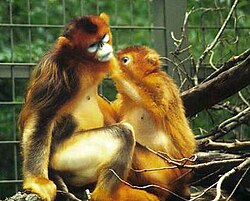Snub-nosed monkey: Difference between revisions
m Reverted test edit (HG) |
No edit summary |
||
| Line 19: | Line 19: | ||
''[[Black Snub-nosed Monkey|Rhinopithecus bieti]]''<br> |
''[[Black Snub-nosed Monkey|Rhinopithecus bieti]]''<br> |
||
''[[Gray Snub-nosed Monkey|Rhinopithecus brelichi]]''<br> |
''[[Gray Snub-nosed Monkey|Rhinopithecus brelichi]]''<br> |
||
''[[Tonkin Snub-nosed |
''[[Tonkin Snub-nosed Monkey|Rhinopithecus avunculus]]'' |
||
}} |
}} |
||
| Line 42: | Line 42: | ||
** [[Black Snub-nosed Monkey]], ''Rhinopithecus bieti'' |
** [[Black Snub-nosed Monkey]], ''Rhinopithecus bieti'' |
||
** [[Gray Snub-nosed Monkey]], ''Rhinopithecus brelichi'' |
** [[Gray Snub-nosed Monkey]], ''Rhinopithecus brelichi'' |
||
** [[Tonkin Snub-nosed |
** [[Tonkin Snub-nosed Monkey]], ''Rhinopithecus avunculus'' |
||
==References== |
==References== |
||
Revision as of 16:17, 26 March 2009
| Snub-nosed monkeys | |
|---|---|

| |
| Golden Snub-nosed Monkey (Rhinopithecus roxellana) | |
| Scientific classification | |
| Kingdom: | |
| Phylum: | |
| Class: | |
| Order: | |
| Family: | |
| Subfamily: | |
| Genus: | Rhinopithecus Milne-Edwards, 1872
|
| Type species | |
| Semnopithecus roxellana Milne-Edwards, 1872
| |
| Species | |
|
Rhinopithecus roxellana | |
The snub-nosed monkeys are a group of Old World monkeys and make up the entirety of the genus Rhinopithecus. The genus occurs rarely, and needs much more research. Some taxonomists group snub-nosed monkeys together with the Pygathrix genus.
Snub-nosed monkeys live in Asia, with a range covering southern China (especially Tibet, Sichuan, Yunnan, and Guizhou) as well as the northern part of Vietnam.
These monkeys get their name from the short, stump of a nose on their round face, with nostrils arranged forward. They have relatively multicolored and long fur, particularly at the shoulders and backs. They grow to a length of 51 to 83 cm with a tail of 55 to 97 cm.
Snub-nosed monkeys inhabit mountain forests up to a height of 4000 m, in the winter moving into the deeply secluded regions. They spend the majority of their life in the trees. They live together in very large groups of up to 600 members, splitting up into smaller groups in times of food-scarcity, such as in the winter. Groups consist of many more males than females. They have territorial instincts, defending their territory mostly with shouts. They have a large vocal repertoire, calling sometimes solo while at other times together in choir-like fashion.
The diet of these animals consists mainly of tree needles, bamboo buds, fruits and leaves. A multi-chambered stomach helps them with digesting their food.
The impulse for mating starts with the female. She takes up eye contact with the male and runs away a short bit, then flashes her genitals. If the male shows interest (which does not always occur), he joins the female and they mate. The 200-day gestation period ends with a single birth in late spring or early summer. Young animals become fully mature in about 6 to 7 years. Zoologists know little about their lifespan.
Species
- Genus Rhinopithecus
- Golden Snub-nosed Monkey, Rhinopithecus roxellana
- Moupin Golden Snub-nosed Monkey, Rhinopithecus roxellana roxellana
- Qinling Golden Snub-nosed Monkey, Rhinopithecus roxellana qinlingensis
- Hubei Golden Snub-nosed Monkey, Rhinopithecus roxellana hubeiensis
- Black Snub-nosed Monkey, Rhinopithecus bieti
- Gray Snub-nosed Monkey, Rhinopithecus brelichi
- Tonkin Snub-nosed Monkey, Rhinopithecus avunculus
- Golden Snub-nosed Monkey, Rhinopithecus roxellana
References
- Groves, C. P. (2005). Wilson, D. E.; Reeder, D. M. (eds.). Mammal Species of the World: A Taxonomic and Geographic Reference (3rd ed.). Baltimore: Johns Hopkins University Press. pp. 173–174. ISBN 0-801-88221-4. OCLC 62265494.
